Discovering Paddle Boarding: Techniques and Tips

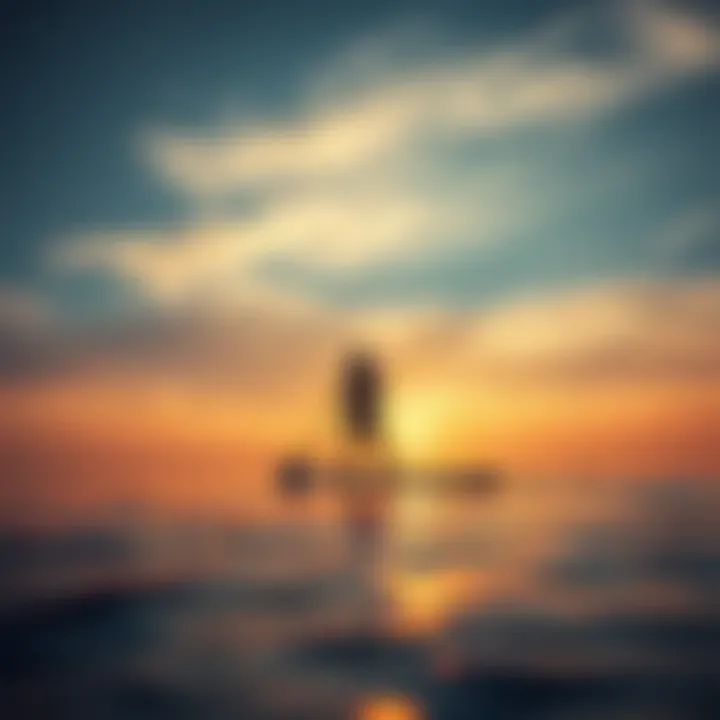
Intro
Paddle boarding has become more than just a pastime; it’s a gateway to new adventures, combining the thrill of exploration with an unparalleled sense of serenity. Whether you find yourself gliding across calm lakes or battling the waves in the ocean, the allure of paddleboarding is hard to resist. As we embark on this exploration, it’s essential to gather our bearings—understanding the gear and equipment that ensure safety and enhance the experience. We'll also dive into the skills needed to navigate various waters, making the most of what this sport has to offer. Let’s journey through the essential facets of paddle boarding, equipping ourselves with knowledge that ranges from gear selection to mastering techniques.
Gear and Equipment
When it comes to paddle boarding, the right gear can make or break your experience.
Latest Paddle Board Technologies
In recent years, technological advancements have transformed paddle boards into more innovative and user-friendly equipment.
- Inflatable Boards: These have gained popularity owing to their portability. Easy to inflate and deflate, they’re a top pick for travelers. Brands like Red Paddle Co are known for their durable and lightweight designs.
- Epoxy Boards: Offering enhanced buoyancy and rigidity, these boards are ideal for those who favor performance and stability. Companies like Bic Sport and Starboard deliver exceptional options for serious enthusiasts.
- Eco-Friendly Materials: Sustainability is at the forefront now. Paddle boards are being crafted from eco-conscious materials, such as recycled plastics or bamboo, making them more appealing to environmentally aware consumers.
Essential Accessories for Every Surfer
Accessories might seem trivial, but having the right ones can elevate your paddle boarding experience. Some must-haves are:
- Paddle: An adjustable paddle is essential for comfort and efficiency.
- Leash: This keeps the board tethered to you, crucial for safety, especially in open water.
- Life Vest: A well-fitted personal flotation device should always be on your list.
- Dry Bag: Keeping essentials safe and dry is vital during your adventures.
- Sunscreen: Not an accessory per se, but protecting your skin from sun exposure cannot be overlooked.
Surf Techniques and Skills
Learning the ropes (or should we say paddles?) of paddle boarding involves honing various techniques that suit your skill level.
Beginner Surfing Techniques
For those setting foot on a board for the first time, focus on the basics:
- Stance: Position yourself with feet shoulder-width apart, knees slightly bent, and gaze forward.
- Paddle Stroke: Use long, smooth strokes on one side to steer. Switch sides to maintain straight direction.
- Stopping: Drag the paddle in the water on the opposite side to slow down. Practicing stopping will help you gain confidence.
Advanced Maneuvers for Experienced Surfers
Once you’ve mastered the basics, it’s time to step it up:
- Turning: Learn the pivot turn, which uses your paddle to push against the board’s nose, allowing for swift changes in direction.
- Riding Waves: Align your board perpendicular to the wave and paddle hard as it approaches, then shift your weight back to maintain balance.
- Carving: Lean into turns and use your paddle as leverage to carve through the water effectively.
Paddle boarding offers a dynamic blend of physical activity and mental clarity. With the right equipment and skills, you can explore diverse aquatic environments and experience the unique cultural significance this sport holds around the world. Ready to catch the next wave? Let’s paddle on!
Prolusion to Paddle Boarding
Paddle boarding has carved out a unique niche in the realm of aquatic sports, standing out for its blend of physical engagement and serenity found on the water. The increasing popularity of this sport is not just a trend, but rather a testament to its versatility and accessibility. Understanding paddle boarding can provide both thrill-seekers and leisure lovers a pathway to connect with nature in a distinctly personal way.
Definition and History
The practice of paddle boarding, often referred to as stand up paddle boarding (SUP), can trace its origins back to the early Polynesians who used similar techniques to navigate their islands. Fast forward to the 20th century, surf instructors in Hawaii picked it up, standing on their boards to get a better view of the waves and their students. This simple act birthed a sport that marries traditional surfing with a newfound element of balance and stability. From its humble beginnings, paddle boarding has soared in popularity across the globe, evolving into a multifaceted sport that appeals to individuals of all skill levels.
Why Paddle Board?
There are numerous reasons why one might take to paddle boarding, and each individual will find their own motivation. Some seek adventure, eager to explore hidden coves or rivers winding through lush landscapes. Others might be drawn by the meditative aspect, as the rhythmic motion of paddling glides you into a tranquil state far from the chaos of daily life.
- Health Benefits: Paddle boarding is not merely a pastime; it brings numerous health advantages too. Consistent paddling can improve core strength, enhance cardiovascular health, and boost endurance.
- Social Connection: Joining a local paddle boarding community can introduce one to like-minded enthusiasts. Whether through clubs or social gatherings, sharing experiences while paddling can foster lasting friendships.
- Accessibility: Unlike many sports, paddle boarding doesn't require a high level of physical prowess to begin. With a little guidance and practice, individuals can paddle across calm lakes, oceans, or rivers while genuinely enjoying the experience.
"Paddle boarding allows you to explore landscapes that are often inaccessible by foot, offering a unique vantage point of nature that is hard to beat."
As we navigate through the world of paddle boarding, both the practicalities and the joys will be highlighted, allowing one to fully embrace whatever draws them to this captivating sport.
Essential Equipment
The backbone of a successful paddle boarding experience lies in the equipment we choose. Having the right gear can make all the difference, not just in terms of performance but also safety and comfort. Understanding the essentials means diving into the specifics of what constitutes quality gear. In this realm, paddle boards and paddles reign supreme, but accessories play significant roles too, elevating the overall experience.
Types of Paddle Boards
All-Around Boards
All-around boards represent the Swiss Army knife of paddle boarding. Versatile in nature, these boards are typically wider and more stable, making them ideal for both beginners and those looking to casually paddle across lakes or calm waters. Their key characteristic is their balance of speed and stability. This adaptability makes them a popular choice in the paddle boarding community. The unique feature of all-around boards is their ability to perform adequately in various waters, accommodating diverse paddling styles, whether it's flat water or mild waves. However, their versatility comes with a price; they may not excel in specific conditions like racing or surfing, which some might find limiting.
Touring Boards
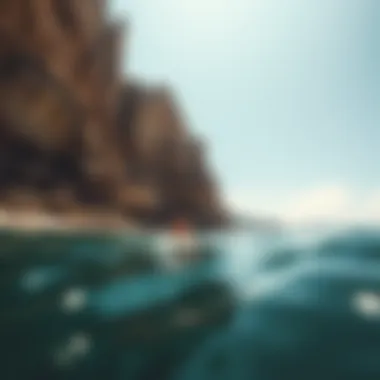

When you're looking for distance and speed, touring boards have got your back. These boards are designed for long paddles, typically longer and usually more pointed, allowing for a quicker glide through the water. Their key characteristic is streamlined efficiency, making them a beneficial option for those who enjoy extended paddling sessions or exploring coastlines.
Touring boards usually feature storage options, enabling paddlers to carry gear for longer outings. However, the increased length and narrower design can compromise stability, especially for novice paddlers who may prefer the sturdiness of an all-around model.
Surf Boards
For those drawn to the allure of surfing, paddle boards designed for this purpose can be your ticket to riding those ocean waves. Surf boards are shorter, with a more pronounced rocker, enhancing maneuverability on the surf. Their critical characteristic lies in their responsiveness to waves, making them a favorable choice for those wanting to blend paddle boarding with surfing.
A unique feature of these boards is their ability to handle powerful waves, but the trade-off here is that they can be less stable for casual paddling. Experienced surfers often appreciate these boards for the thrill they bring, yet beginners might find them challenging to balance on.
Inflatable vs. Rigid Boards
The age-old debate between inflatable and rigid boards often stirs passionate discussions among paddle boarders. Inflatable boards are lightweight and easily transportable, making them a convenient choice for those with limited storage space or those who travel often.
A standout feature of inflatables is their durability; they can absorb impacts better than rigid boards, which is particularly advantageous in rocky areas. However, some paddlers argue that rigid boards offer better performance and speed due to their solid construction. On the flip side, rigid boards tend to be heavier and less portable, which can deter some enthusiasts who prefer the ease of inflatables.
Paddles and Accessories
Choosing the Right Paddle
Selecting the right paddle is crucial as it directly affects your paddling efficiency. The most significant factor is the paddle's length, which should ideally be about 6 to 8 inches taller than you. A key characteristic of a well-chosen paddle is its lightweight material, often made from either fiberglass or carbon fiber for an easy stroke. Opting for the correct paddle can transform your experience, making it significantly more enjoyable.
The unique feature of quality paddles often is the adjustable length; this allows the paddle to be shared among individuals of varying heights or for switching between different paddling styles. However, some might find that more expensive paddles, while lighter, are not always necessary, especially for casual users.
Safety Gear Essentials
With any water sport, safety is paramount. Key safety gear may include life jackets, leashes, and even inflatable vest jackets for emergency situations. These items are essential for ensuring a secure and worry-free paddle boarding experience.
A noteworthy feature of safety gear is that it can often be lightweight and streamlined, ensuring it doesn't hinder movement. The inclusion of these safety essentials is not just a precaution; it embodies responsible paddling practice, as rough waters can appear out of nowhere. However, some may resist wearing life jackets due to discomfort; finding one that fits well can mitigate this concern.
Additional Accessories for Comfort
While paddle boards and paddles are fundamental, accessories for comfort enhance the overall journey. Consider options like padded seat cushions, dry bags for essentials, or even coolers for a day out on the water. The main draw of these additional accessories is their ability to make longer outings far more pleasant.
Unique features of comfort accessories can significantly improve your experience, such as a high-back seat that provides lower back support or a cooler that doubles as a seat. However, extra gear means more items to carry; thus, it's wise to evaluate what is essential before heading out.
"Having the right equipment can turn a good day into a great one on the water."
Choosing the right gear contributes not just to your safety but also influences your enjoyment and performance, whether you're paddling on serene lakes or carving through surfable waves. Explore these options and find what suits your style best.
Techniques and Skills Development
Diving into paddle boarding isn’t merely about gliding on water; it’s about mastering the skills that transform you from a complete novice into a confident paddler. Techniques and skills are the bedrock of enjoying this sport while ensuring your safety and proficiency on the water. It’s like learning to dance—the more comfortable you are with your movements, the more you can enjoy the rhythm of the waves. Developing a strong foundation in techniques not only enhances your ability to navigate diverse water conditions but also allows you to connect more deeply with the paddle boarding community. The right techniques can minimize injuries and improve your overall experience.
Beginning Paddle Boarding
Stance and Balance
When you first step onto a paddle board, your stance and balance can make all the difference. Your feet should be placed shoulder-width apart, with your knees slightly bent. This position helps you maintain equilibrium and absorb the movements of the water beneath. A solid stance is not just beneficial but essential; it’s what keeps you from taking an unexpected swim. Proper balance allows you to respond swiftly to changes in conditions and even lets you take in the sights without the fear of tipping over.
One unique feature of maintaining a strong stance is that it empowers you to shift your weight efficiently. If you need to turn or alter your course, your body can adapt smoothly without a panic-induced wobble. Generally, a good stance becomes more second nature the more you practice, transforming it from a conscious effort into an instinctive action.
However, newer paddlers may find it challenging at first, sometimes feeling as if they're walking a tightrope. This initial discomfort can be a hurdle, but with practice comes improvement. Most importantly, a solid stance can greatly enhance your confidence on the water, making every outing more enjoyable.
Basic Paddle Techniques
Moving on to the paddle itself, mastering basic paddle techniques is crucial for effective movement across the water. The typical stroke involves dipping the paddle blade into the water and pulling it back, which propels you forward. The key characteristic of this technique is timing; a well-timed stroke can make your paddling efforts feel effortless. Using a proper paddle hold—gripping the top of the paddle with one hand while the other is farther down the shaft—can deliver power and efficiency during your strokes.
A standout feature of basic paddle techniques is adaptability. Once you get the hang of it, you can easily modify techniques for different paddling environments. However, beginners might find it tempting to over-exert themselves, leading to fatigue. That’s where practice helps; with each session, you’ll develop rhythm and intensity that match your comfort level, optimizing energy expenditure.
Advanced Techniques
Turning and Maneuvering
Turning and maneuvering are advanced skills that significantly enhance your paddle boarding experience. Learning to pivot swiftly allows you to navigate tight spots, dodge obstacles, or simply enjoy a leisurely scenic course without losing your pace. The typical method is the sweep stroke, where you draw the paddle wide to turn in the desired direction. This technique is not only effective but can also become a fun facet of your paddle boarding progression.
One unique aspect of turning is how it encourages you to engage your core muscles. A strong core can propel you further while giving you more control over the board. Getting the hang of turning involves practice and patience, of course—there’s no shortcut to mastering it. Some beginners may struggle with coordination, but through solid practice, you’ll find yourself turning and maneuvering seamlessly as if you were born to do it.
Riding Waves
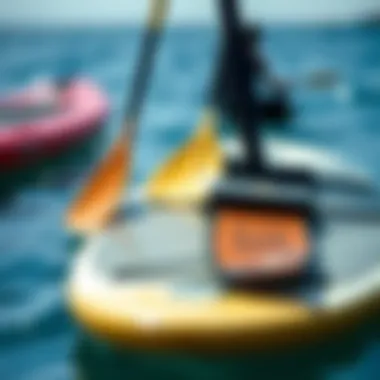
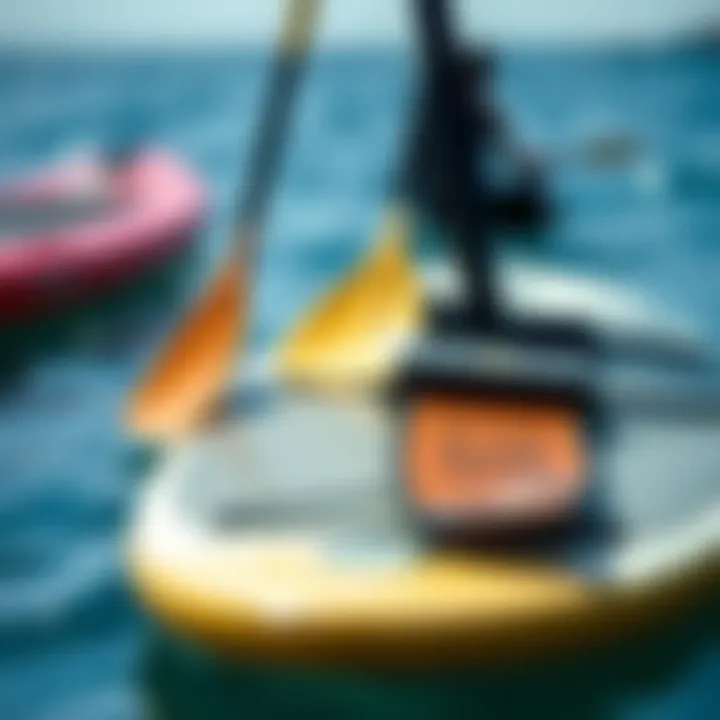
For those looking to add excitement to their paddle boarding journey, riding waves is where the thrill lies. It’s not just a physical challenge but an art of anticipation and reaction. Successfully riding waves demands an understanding of wave patterns, positioning, and timing your strokes just right to catch that exhilarating lift.
The key characteristic of this technique is its dynamic nature; every wave is different, requiring you to adapt. It’s also a testament to the thrill that paddle boarding can provide. Though it may take some time to master, riding waves grants you the unique experience of gliding over the crest, feeling the ocean’s pulse. Yet, it’s important to note the risks involved—navigating waves often requires good judgment of currents and careful consideration of safety. Beginners should first hone their fundamentals before diving into this exhilarating endeavor.
"Mastering the basics opens doors to advanced skills, ensuring every paddle boarding outing is not just an activity but an adventure."
For more tips and community experiences related to paddle boarding techniques, check out forums like Reddit and local clubs via Facebook. They are gold mines of information ranging from personal anecdotes to shared tips!
Choosing the Right Location
Selecting the perfect spot for paddle boarding can significantly shape one's experience on the water. From tranquil lakes to bustling rivers and coastlines, the environment influences both the skill level required and the overall enjoyment. Factors that come into play include weather conditions, water currents, and potential hazards. Choosing an ideal location helps in enhancing one's confidence and enjoyment while reducing the risks associated with the sport. When examining where to paddle board, understanding the unique features of various settings can make a world of difference.
Best Natural Settings
Lakes and Rivers
Paddle boarding on lakes and rivers can be a transformative experience. One key characteristic of these bodies of water is their typically calm surface, which allows beginners to find their footing without the worry of crashing waves. Lakes are often surrounded by stunning natural landscapes, offering a serene backdrop that complements the paddle boarding journey.
The unique feature of lakes is their generally flat and predictable water, making them accessible for families and those new to the sport. However, rivers can introduce elements of mild current and varying depths. Depending on the section of the river, it might offer gentle paddling experiences or something more adventurous that calls for better technique and awareness. The scenic routes often available along lakes and rivers provide visual splendor that can enhance the entire outing. Still, it’s crucial to stay informed about local wildlife or potential underwater obstacles, as they might present challenges.
Coastal Areas
Coastal areas represent a different ballgame entirely. With the rhythmic ebb and flow of ocean waves, these settings can be both exhilarating and intimidating. The primary allure of paddle boarding in coastal areas is the chance to ride waves, which offers a separate thrill altogether compared to flat water. These locations allow paddle boarders to engage the skills they’ve learned while also challenging themselves with varying wave conditions.
One unique aspect of coastal paddle boarding is the interaction with marine life - dolphins, sea turtles, and vibrant fish can sometimes be seen while paddling along. However, the rapid changes in tides and strong currents found in coastal regions can also be dangerous. Knowledge of the specific area, along with the fluctuations in weather, becomes essential. Those new to paddling in such places should consider starting at more sheltered beaches to develop necessary skills gradually.
Open Water
Paddle boarding in open water, such as oceans or large lakes, opens the door to a broader adventure. Open water offers expansive views and might accommodate a true sense of freedom away from land. Paddle boarders can traverse longer distances, ideally suited for the experienced individual seeking exploration. However, this setting comes with its set of risks, including unexpected waves, changing weather patterns, and potential separation from safety points.
The vastness of open water allows for ample opportunities to paddle towards islands or remote shores, connecting with nature in a way that's quite profound. However, safety should always be a paramount concern, particularly when paddling far from shore. A solid understanding of weather conditions, currents, and navigation skills can really impact one’s paddle boarding adventure in open water.
Urban Paddle Boarding
Paddling in City Environments
Paddling in city environments offers a unique twist on paddle boarding. Urban locations often incorporate rivers or man-made lakes within popular parks or urban developments. These settings can yield a vibrant atmosphere where nature meets city life. Being able to paddle while surrounded by skyscrapers adds an urban charm that's hard to replicate elsewhere.
This choice provides a distinctive social experience since many city-dwellers are also looking for recreational activities close to home. However, it's vital to remain aware of your surroundings. Navigating urban infrastructure, including bridges and boat traffic, requires extra attention and may present challenges that are less common in more natural settings. Safety precautions, such as wearing life jackets and being aware of local regulations, become even more important in these scenarios.
Safety Considerations
Safety considerations in any paddle boarding setting are crucial but especially in urban environments. The presence of other water users, such as kayakers or boaters, calls for heightened awareness. Knowing local rules and regulations concerning paddle boarding and other water activities is essential for safety. Each area might have different requirements regarding life jackets or communication devices.
Moreover, understanding urban weather conditions can be tricky, as city landscapes can affect wind and weather patterns, leading to sudden changes that pose risks. Meeting with local groups or communities can provide valuable insights concerning specific safety measures and best practices. Engaging with experienced paddle boarders in the area further equips a novice with necessary knowledge, ensuring that they are fully prepared for whatever the waters may bring.
Safety Considerations
Safety in paddle boarding is pivotal, not just for the pleasure of the sport but also for ensuring a sustainable and enjoyable experience across various water environments. Understanding potential hazards, preparing for unpredicted situations, and adhering to safety protocols contribute to a secure outing on the water. Here, we unpack some essential elements of safety considerations that paddle boarders must keep in mind.
Understanding Weather Conditions
Weather conditions can shift faster than a flick of a switch, and having an awareness of them is crucial for paddle boarding. Before you even think about entering the water, check the forecast. Is it sunny today but with storms looming on the horizon? Is there a chance of strong winds that could gust your board right into a rocky area? Knowing these factors can save you from a harrowing experience.
- Wind: Light winds can enhance your paddle experience; however, strong winds may lead to choppy waters, which are not ideal for beginners. Even seasoned paddlers can find themselves struggling against unexpected gusts.
- Temperature: It’s essential to avoid getting too cold or too hot. A good rule of thumb? If the water is below 70°F and you're not in a wetsuit, consider staying on shore. Hypothermia is no joke.
- Visibility: Fog can sneak up on you like a thief in the night, drastically reducing visibility. If you’re planning on paddling, ensure you have a clear view to navigate safely.
Incorporate weather apps and reliable websites into your pre-paddle routine. Local services, like weather.gov, offer accurate forecasts that could be the difference between a fun day on the water and one filled with peril.
Self-Rescue Techniques
Even with meticulous planning, accidents may happen—it’s part of being on the water. Knowing how to get back on your board is just as important as knowing how to ride it.
- Falling Off: If you find yourself taking an unexpected plunge, don’t panic. Just swim to the side of your board and grab it. If you’re in open water, perform a simple maneuver:
- Trim and Wobble: If you’ve got waves or a heavy current, you might feel like a fish out of water again. Lean to your knees on the board before standing up again, which makes it easier to regain balance.
- Paddle as a Lever: If you’re struggling and can’t manage to get back on, your paddle can serve as a lever. Use it to press against the board while you pull body to shimmy back on.
- Position Yourself: Kick your legs and swim towards the board. Reach out for the handle if your board has one.
- Getting Back On: Once near it, try to position your body towards the tail of the board. This will help stabilize it as you climb on. Use your arms to pull yourself up in a swift motion, keep your weight low.
"In every outdoor activity, preparation is the key. Know thyself and the environment to truly embrace the experience."
Ultimately, paddle boarding is a rewarding endeavor when approached with safety in mind. Knowing weather conditions and how to handle difficult situations can lead to a more enjoyable experience on the water. Make it a habit to review these aspects regularly. For more detailed guides, feel free to check resources like Wikipedia or Reddit, where many seasoned enthusiasts share personal tips, stories, and tricks of the trade.
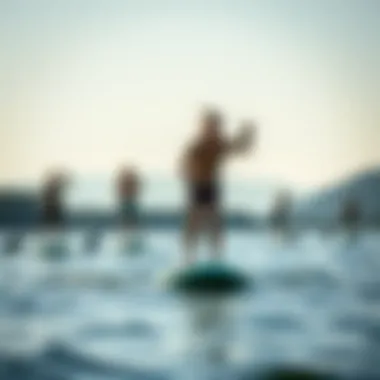
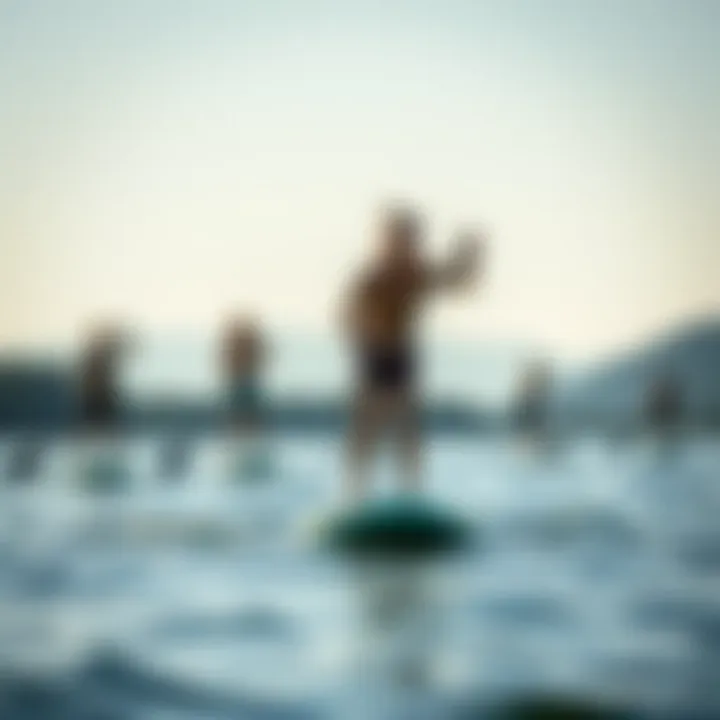
Cultural and Recreational Aspects
Paddle boarding is more than just a solo endeavor on the water; it reflects a vibrant cultural tapestry woven together by enthusiasts from various backgrounds. This section unpacks the significance of communities and environmental considerations important in preserving and cherishing the sport.
Paddle Boarding Communities
Local Clubs and Competitions
Participating in local clubs and competitions can offer unmatched benefits to paddle boarding enthusiasts. These clubs serve as hubs for like-minded people who share a passion for the water. They create a platform where novices can learn from seasoned paddlers, thus enhancing skills and confidence among all members.
A key characteristic of these clubs is the sense of camaraderie they foster. For many, joining a local club is akin to joining a family. Regular meet-ups allow club members to exchange techniques and experiences, making everyone feel like part of the community. Moreover, competitions provide healthy challenges and opportunities for paddle boarding enthusiasts to push their limits and gain recognition for their skills. However, competition can also lead some to feel overwhelmed or pressured. Balancing competition and friendship is crucial for sustaining an inviting atmosphere.
Some unique activities hosted by local clubs include weekend excursions and paddle boarding workshops. These events not only enhance technical skills but also build lasting friendships among participants. The casual atmosphere helps discourage elitist attitudes that can sometimes crop up in sports communities.
Social Media Presence
In today’s world, having a solid social media presence plays an essential role in fostering paddle boarding communities. Platforms like Facebook and Instagram allow paddle boarders to connect across borders, sharing experiences, tips, and breathtaking sceneries that accompany their adventures.
This pervasive online presence is beneficial for promotion and recruitment within the paddle boarding community. Enthusiasts can showcase their tips, stories, and favorite paddle spots, encouraging more adventurous souls to join their ranks. An important feature of social media is the immediacy with which information can spread. However, it also has its drawbacks; unrealistic expectations can sometimes stem from filtered photos and exaggerated stories that don't capture the realities of the sport. Despite these pitfalls, a positive social media presence can create an inclusive atmosphere, where newbies feel welcomed and motivated to dive in.
A downside is it may occasionally create a disconnect between online interactions and the real-world experience. The essence of paddle boarding is still undoubtedly rooted in the connections made out on the water itself.
Environmental Impact
Paddleboarding does not exist in a vacuum. Engaging responsibly with nature is a crucial theme for the culture surrounding this sport. The impacts of paddleboarding on local ecosystems are significant, urging enthusiasts to adopt practices that contribute to the preservation of waterways.
Eco-Friendly Practices
Adopting eco-friendly practices is vital for safeguarding the environments we paddle in. Many paddle boarders have begun to embrace leave-no-trace principles and actively participate in clean-up efforts. These practices encourage paddlers to be mindful: from using biodegradable cleaning supplies for gear to avoiding single-use plastics, every choice can contribute to a cleaner natural habitat.
Moreover, some paddle board manufacturers are prioritizing sustainability as well. They have started to use environmentally friendly materials in their boards and accessories, reflecting a growing trend towards responsible production. Eco-friendly practices create a shared sense of purpose within the paddleboarding community, prompting more people to take an interest in conservation. However, it can be challenging to change long-held habits, requiring consistent education and outreach within the community.
Promoting Conservation Efforts
In addition to eco-friendly practices, paddle boarders can actively promote conservation efforts, participating in initiatives aimed at preserving local ecosystems. Regular beach clean-ups are examples of collective action where individuals come together for a common cause. These efforts not only benefit the local environment but also serve to strengthen community bonds.
A unique aspect of such initiatives is that they make paddlers more aware of their impact on nature. This heightened awareness can often lead to advocacy for policies benefiting marine environments. However, the challenge lies in galvanizing enough interest and participation, as conservation efforts can often be labor-intensive and require ongoing commitment. Yet, the positive outcomes can feed back into paddleboarding culture, allowing the community to thrive harmoniously with their natural surroundings.
Ultimately, paddle boarding's cultural and recreational aspects encompass much more than just the act itself. By participating in local clubs, utilizing social media, and actively engaging in environmental stewardship, paddle boarders enrich their own experiences while contributing positively to the broader world.
Maintaining Your Equipment
Maintaining your paddle board and equipment is a critical aspect of the paddle boarding experience. Proper upkeep not only extends the lifespan of your gear but also ensures that your adventures on the water are safe and enjoyable. Think about it: if you wouldn't head out for a day of hiking without checking your boots, why would you neglect your paddle board?
Storage and Cleaning
Keeping your paddle board in tip-top shape begins with how you store it. Ideally, you want to store your board in a cool, dry place out of direct sunlight. Long exposure to UV rays can cause the decking material to break down, leading to a shorter lifespan. A board bag can provide both protection and ease of transportation.
When it comes to cleaning, a simple rinse with fresh water after every use goes a long way. Some people prefer to scrub their board with a soft brush and mild soap, especially if they’ve been paddling in saltwater or muddy conditions. This helps eliminate any algae or grime that may cling on. After scrubbing, make sure to rinse thoroughly to avoid soap residue.
A common practice some paddle boarders use is to invest in a non-toxic cleaner specifically designed for paddle boards. Not only do these cleaners remove dirt and salt, but they can also protect against UV damage and fading of colors. Make it a habit to check for any nicks or scratches while cleaning; a little attention now can save you a big headache later.
Repairs and Upgrades
Even with the best care, wear and tear will happen. It’s crucial to know how to perform basic repairs—your equipment's longevity hinges on this. Knowing how to fix a small ding or puncture can prevent more significant damage down the line. For instance, if you notice a minor crack in your board, using a repair kit can help seal it before it turns into a larger issue. You can also find tutorials online to guide you through repairing common problems.
Upgrading your gear can also enhance your experience on the water. You might consider a better paddle or maybe even an electric pump for inflatables. Not all upgrades need to break the bank; sometimes, a small adjustment, like using a different fin setup, can greatly improve performance in varying water conditions.
"Keeping your paddle board well-maintained isn’t just a chore; it’s investing in future adventures."
End
Reflecting on the journey through paddle boarding brings to light not just the thrill of gliding across the water but the deeper connections formed along the way. This activity serves as a bridge between nature and the individual, offering an escape from the digital grind. Paddle boarding isn’t merely about balance and technique; it’s about understanding one’s self amid serene waters.
Reflecting on the Paddle Boarding Journey
As you set sail on your paddle boarding journey, consider the layers of experience that unfold with each stroke. First and foremost, there's the physicality of it—a full-body workout that strengthens muscles while you traverse tranquil lakes or conquer ocean waves. Not to mention, the sense of peace found in nature is something hard to replicate in everyday life. Being on the board allows for moments of introspection and clarity; it’s not just you and the water—it's you, the water, and the world around you, working in exquisite harmony.
Taking part in this sport also introduces paddlers to vibrant communities, each with their own unique narratives and camaraderie. Whether you’re at a local meet-up or joining global paddle boarding events, the connection to fellow enthusiasts magnifies the experience. This sense of belonging is profound, transforming the solitude sometimes inherent in individual sports into shared joy.
Additionally, many paddle boarders find themselves evolving into advocates for the environments they explore. Engaging with nature often ignites a passion for conservation and sustainability. It's vital to approach this journey with an eco-conscious mindset. With paddle boards contributing less to water and land pollution than motorized watercrafts, it sets the stage for ecological stewardship.
A paddle boarding journey is a personal odyssey—a reflection of strength, serenity, and social connection.
As we wrap up our exploration of paddle boarding, bear in mind the various threads that weave together the essence of the sport. The adventure it opens up, the friendships forged, and the environmental awareness cultivated make it immensely valuable. Each trip across the water can be a moment of discovery, both of the world outside and the self within. Thus, whether you are a novice just learning the ropes or a seasoned expert catching waves, every paddle is a step into a deeper understanding of life on the water.







